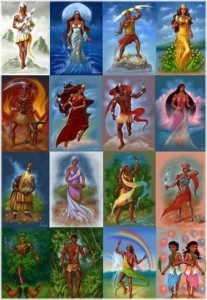Babalu Aye, San Lazaro, Azojano is one of the most loved, respected, feared, and venerated Orishas in the Cuban Santeria tradition.
Babalu Aye is the Orisha who reigns over all matters related to health, psychical, and spiritual.
Babalu Aye is the protector of the sick, the weak, the hurt, the injured.
Babalu Aye is a miraculous and humble Orisha, the Orisha of healing and disease.
Babalu Aye appears as a sick man with sores and trembling arms and legs that is why it is syncretized with Saint Lazarus in the Cuban Santeria tradition.
Babalu Aye teaches compassion, love, and responsibility.
Babalu Aye is worshipped and respected for all the miracles he performs, he is particularly known for his healing powers.
Babalu Aye is accompanied by two dogs and wears cloth made of burlap with purple adornments.
In the Lukumi tradition, Babalu Aye was punished by Olofi (God) with sickness & afflictions. He lost his health, riches & prosperity for not having good character and for being disobedient. Babalu Aye’s trials on earth are a lesson of humility; perseverance, integrity, and good character.
Babalu Aye is also the protector of all animals, especially dogs. Dogs were his only companion (besides Elegua) when he was suffering his trials & tribulations.
Babalu Aye is loving but stern, no one wants to be on his bad side and meet his wrath. Babalu Aye is loved, respected, and feared.
Babalu Aye’s colors are royal purple, yellow and brown. His sacred number is 17. Burlap is sacred to him and used in his offerings & items made for him.
December 17th is a day we honor Babalu Aye, many celebrations are done on December 16th waiting for midnight.
In the Santeria tradition, the ceremonial for worshiping Babalu Aye is called The Awan
In this ceremony, Babalu Aye is placed next to a basket lined with burlap material with offerings are placed around it. At nighttime, the lights go down, the only lighting used are the candles, everyone gathers around the basket and cleanse each one with the contents of the plates to remove negativity, for protection, health, and prosperity. After cleansing, the items are cast into the main basket.
This ceremony brings the Ashe of Babalu Aye to the lives of those present.
Babalu Aye represents health and sickness, humility and pride, abundance and scarcity, love and fear.
